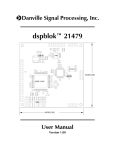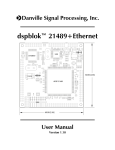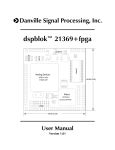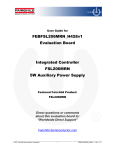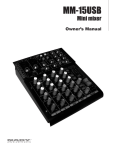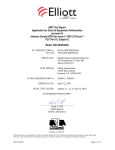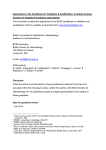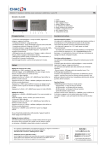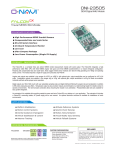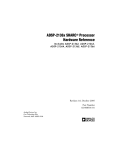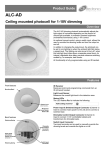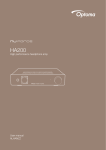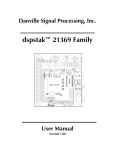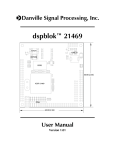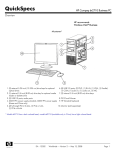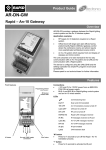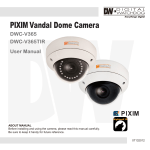Download dspblok™ 21369zx User Manual - Danville Signal Processing, Inc.
Transcript
Danville Signal Processing, Inc. dspblok™ 21369zx User Manual Version 1.01 Danville Signal Processing, Inc. dspblok™ 21369zx User Manual Copyright © 2006-2010 Danville Signal Processing, Inc. All rights reserved. Printed in the USA. Under the copyright laws, this manual may not be reproduced in any form without prior written permission from Danville Signal Processing, Inc. Danville Signal Processing, Inc. strives to deliver the best product to our customers. As part of this goal, we are constantly trying to improve our products. Danville Signal Processing, Inc., therefore, reserves the right to make changes to product specification or documentation without prior notice. Updated operating manuals and product specification sheets are available at our website for downloading. This manual may contain errors, omissions or “typo’s”. Please send your comments, suggestions and corrections to: Danville Signal Processing, Inc. 38570 100th Avenue Cannon Falls, MN 55009-5534 Trademark Notice dspblok and dspstak are trademarks of Danville Signal Processing, Inc. VisualDSP++ and SHARC are trademarks of Analog Devices, Inc. Contact Information Danville Signal Processing, Inc. 38570 100th Avenue Cannon Falls, MN 55009 E-mail: Web Site: [email protected] http://www.danvillesignal.com Voice: 507-263-5854 Fax: 877-230-5629 dspblok™ 21369zx User Manual Page 1 Table of Contents Overview..................................................................................................................3 dspblok™ 21369zx ................................................................................................................................... 3 Intended Audience ...................................................................................................3 Getting Started..........................................................................................................4 Hardware Overview .................................................................................................5 Power Supply............................................................................................................................................ 5 Memory.................................................................................................................................................... 7 DAI & DPI ................................................................................................................................................ 7 Data Bus ................................................................................................................................................... 7 Clocks....................................................................................................................................................... 7 Multiprocessor Configurations ................................................................................................................... 7 Reset......................................................................................................................................................... 8 Signal Levels ............................................................................................................................................. 8 Boot Options ............................................................................................................................................ 8 Connections .............................................................................................................9 Connector Recommendations & Notes ...................................................................11 Connector Specification .......................................................................................................................... 11 JH1 – JTAG (External ICE)........................................................................................................................ 11 JH2 – DAI, DPI, IO ................................................................................................................................. 11 JH3 – JTAG - AUX ................................................................................................................................... 11 JH4 – Power & Clock .............................................................................................................................. 11 JH5, JH6, JH7 – Data Bus........................................................................................................................ 11 JH8 – Boot and Clock Mode Configuration ............................................................................................. 12 Mechanical Dimensions..........................................................................................13 Schematic...............................................................................................................13 RoHS & WEEE Compliance.....................................................................................14 dspblok™ 21369zx User Manual Page 2 Overview Danville Signal's dspblok™ family of products delivers the power of digital signal processing in a small 60mm x 60mm form factor. Connections are brought out to standard 2mm dual row headers. The dspblok reduces development costs, risk and time. Danville’s dspblok DSP function modules are often incorporated directly into larger custom embedded systems. By taking advantage of pretested signal processing modules, pc board layouts become simpler and projects are completed quickly and cost effectively. You can also create small standalone embedded applications by combining a dspblok DSP function module with other dspblok modules. Embedded dspblok systems are created by using a dspblok power supply (such as our dspblok ps-usb), and an I/O module, such as one of our dspblok ad96k family of audio data converter boards. Each board is stacked via 2mm headers to create a low profile configuration where space is at a premium. dspblok™ 21369zx The dspblok™ 21369zx is a highly integrated DSP module that incorporates an Analog Devices’ ADSP-21369 SHARC DSP operating at 333 MHz with flash, EEProm and SDRAM memory. An onboard switching power supply supports the core voltage requirements of the DSP so that only 3.3V is required to power the dspblok. The ADSP-21369 peripherals include SPORTS (8), SPI(2), TWI (I2C), UART, timers, PWMs, JTAG and a full 32 bit wide data bus. All of these peripherals are available via 2mm headers on the dspblok. The dspblok 21369zx is the foundation of our dspstak™ 21369zx2 and dspstak™ 21369zx DSP Engines. You can use a dspstak 21369zx2 or 21369zx with ICE as a development and programming platform for the dspblok. Intended Audience The dspblok 21369zx requires an understanding of the Analog Devices’ ADSP-21369 and the associated tools used for development. If the dspblok 21369zx is going to be integrated into a larger hardware design, then it is also assumed that the user is familiar with basic hardware design. In most cases, systems integrators, DSP programmers and software engineers can create DSP embedded systems using our embedded dspblok systems (or dspstak family) without the need for additional hardware design and manufacturing. If you do not have a background with these skills, you may want to check out our web site (http://www.danvillesignal.com) as well as the Analog Devices web site for links to useful references. Danville engineers are also available to discuss your application. dspblok™ 21369zx User Manual Page 3 Getting Started We strongly recommend that you use our dspstak 21369zx as an initial development platform. The dspstak 21369zx includes a dspblok 21369zx at its core. This dspstak card provides power and external interfacing connections. This combination gives you a solid footing for development before you incorporate the dspblok into your own target. The 21369zx includes an on-board EZ-Kit style emulator that you can use for development and is supported by both the full version and kit version of Visual DSP++®4.5. The kit version is free. You can also use the dspstak as a dspblok programmer via its USB or RS-232 ports. As another alternative, you can use a dspblok ps-usb power supply as part of a development system as well as a production programmer. The USB port allows you to upload your production firmware to the dspblok 21369zx. In this case, we suggest you consider an Analog Devices HP USB emulator to facilitate your code development. The dspblok 21369zx includes the following items: Hardware: • dspblok 21369zx Module Documents (CD): • • • • This Manual CAD footprints (Gerber & Protel 99SE formats) Schematics Sample Programs We recommend that you have the documents: • • • Analog Devices ADSP-2136x SHARC Processor Hardware Reference Manual Analog Devices ADSP-2136x SHARC Processor Programming Reference Manual Analog Devices ADSP-21160 SHARC DSP Instruction Set Reference Manual We recommend that you have the following tools: • Analog Devices VisualDSP++ 4.5 for SHARC (available from Danville) • Analog Device HP USB ICE (available from Danville) • Danville DSP JTAG adapter or • Danville dspstak 21369zx with ICE or dspstak 21369zx2 with ICE • Analog Devices VisualDSP++ 4.5 for SHARC (optional, KIT license works with dspstak) and • dspblok ps-usb (production programmer via USB) Our website (www.danvillesignal.com) has downloads and links to other tools and documents. dspblok™ 21369zx User Manual Page 4 Hardware Overview The dspblok 21369zx is a small module measuring 60mm x 60mm (2.36” x 2.36”). JH2- JH7 are 2mm male headers that are installed on the bottom side of the pc assembly. JH1 is mounted on the top side of the pc assembly. JH8 is not normally installed. If mating 2mm female headers (4.3mm ht.) are used, the pc assembly will be about ¼” above the mating pc board. This allows standard sized standoffs to be used with the corner mounting holes if desired. The hole size is 0.090” – suitable for 2-56 screws. • JH1 – JTAG (connects to external ICE) • JH2 – DAI, DPI, I/O, SPI & System • JH3 – JTAG (dspstak connection) • JH4 – Power & Ext Clock • JH5, JH6, JH7 – Data Bus • JH8 – Clock & Boot Configuration Power Supply There are two power supply connections to the dspblok: DSP core (Vdd) and DSP I/O and Memory (Vd+3.3). The DSP core supply may range from 3.3V to 5V. This is the input to an on-board switching power supply that supplies 1.3V to the ADSP-21369. DO NOT use a higher voltage supply for the core supply input (JH4-Vdd). A single 3.3V supply is all that is required to power the dspblok 21369zx. A 5V supply will be slightly more efficient but a 3.3V supply may be more convenient. The DSP I/O and Memory supply must be 3.3V. For example, the dspstak 21369zx uses a 3.3V supply to feed the DSP core and the dspblok Vd+3.3 (I/O). On this product, the 3.3V is created by a switching supply that converts directly to 3.3V. Alternatively, a product uses a 5V supply to feed the DSP core (Vdd) and other external 5V I/O devices and also drives a 3.3V LDO. The 3.3V output from the LDO drives the dspblok Vd+3.3 (I/O) and other external 3.3V devices. In this case, it makes no sense to power the dspblok core with 3.3V since the LDO would be dissipating the excess voltage as heat. The dspblok 21369zx requires a single 3.3V supply to operate. An on-board switching supply eliminates the need for an external core supply. This switching supply operates well with a 3.3V input but also accepts 5V as an option. Power consumption is largely a function of the operating clock of the ADSP-21369 and the computation tasks that are being executed on the DSP. The highest consumption occurs when the DSP is performing dspblok™ 21369zx User Manual Page 5 continuous floating point operations at maximum core clock (333MHz). Accessing external I/O such as the SDRAM or other peripherals consumes less power in the benchmarks that we have performed. The following table shows power consumption measurements for a typical dspblok 21369zx operating in a variety of configurations. Typical Power Consumption Core Clock Continuous floating point operations Mixed floating point & DAI operations Mixed floating point & SDRAM operations Continuous floating point operations Mixed floating point & DAI operations Mixed floating point & SDRAM operations mA mA mW mW mW 132mA 180mA 230mA 283mA 119mA 157mA 198mA 239mA 109mA 132mA 159mA 188mA 436mW 594mW 759mW 934mW 393mW 518mW 653mW 789mW 360mW 436mW 535mW 620mW mA mA mA mW mW mW 51mA 63mA 75mA 89mA 370mW 510mW 660mW 815mW 335mW 445mW 560mW 695mW 255mW 315mW 375mW 445mW 34mA 39mA 47mA 53mA 69mW 79mW 92mW 102mW 63mW 76mW 86mW 96mW 112mW 129mW 155mW 175mW 439mW 589mW 752mW 917mW 398mW 521mW 646mW 791mW 367mW 444mW 530mW 620mW Vdd = 3.3V & Vd+3.3 mA 133MHz 200MHz 266MHz 333MHz Vdd = 5.0V Vdd = 5V Core Supply Only 133MHz 200MHz 266MHz 333MHz 74mA 102mA 132mA 163mA 67mA 89mA 112mA 139mA Vd+3.3 Supply Only 133MHz 200MHz 266MHz 333MHz 21mA 24mA 28mA 31mA 19mA 23mA 26mA 29mA Composite Vdd & Vd+3.3 133MHz 200MHz 266MHz 333MHz dspblok™ 21369zx User Manual Page 6 Memory The ADSP-21369 includes an on board SDRAM controller. External SDRAM allows 32 bit wide data to be accessed by the DSP. The ADSP-21369 does not support program execution or extended precision data from the SDRAM. On the dspblok 21369zx, #MS0 is assigned to support the SDRAM. A 2Mx32 (64Mbit) SDRAM is normally supplied with the dspblok. The pcb can support 128Mbit SDRAM as well. Consult Danville if your application requires additional memory. A 4Mbit serial flash memory may be used to bootload the DSP. There is a pre-installed bootloader program that resides in the flash. This program accepts standard ADI loader files (SPI, slave, binary, 8 bit) and can be uploaded with either a dspblok ps-usb power supply or a dspstak 21369zx or zx2. The last block of the flash is reserved for application memory. You can read and write this block from your DSP application. If you want to manage the flash memory yourself, you can overwrite the internal bootloader via the JTAG port. 64kbits of EEProm memory is also available as byte addressable user memory. For example, you might store serial numbers, build versions or calibration values in this space. DAI & DPI The ADSP-21369 has 20 DAI lines and 14 DPI lines. Collectively these can be thought of as two sets of crossbar switches that connect to a wealth of peripherals. The dspblok 21369zx maintains the flexibility of the DAI and DPI by bringing out all 20 DAI and 12 of 14 DPI lines to external connections. The DAI is completely unencumbered and can be assigned to I/O in an arbitrary manner. The DPI is slightly restricted in that the primary SPI interface is assigned to DPI1 (MOSI), DPI2 (MISO), DPI3 (SCK), DPI5 (Flash SS) and DPI6 (EE SS). With the exception of DPI6, these connections are necessary to support SPI master booting. The dspblok 21369zx may also be booted from an external host using SPI slave mode. In this case DPI4 is also used as the #SPIDS line. Data Bus The dspblok 21369zx brings out the complete 32 bit data bus including all address lines with the exception of the SDRAM control lines. #MS1, #MS2 and #MS3 are available for bank memory selection (#MS0 is dedicated to the SDRAM). Clocks The dspblok 21369zx supports both internal and external clocking options. You can add a standard HC49 style crystal to the board for internal clocking or you can supply an external clock. The configuration header (JH8) allows any ADSP-21369 power-up clock configuration to be set. Multiprocessor Configurations The dspblok 21369zx may be used as a coprocessor in a larger system. Perhaps the easiest way to communicate with an external host to configure the secondary SPI port as a slave. The primary SPI port dspblok™ 21369zx User Manual Page 7 remains configured as an SPI master so that it can manage local resources such as flash and EE memory as well as other I/O devices. You can also use SPORTs for interprocessor communication. This can be a good approach in multiple DSP processor applications. For example, you might use several dspbloks to provide front end signal processing for a multichannel application. The results could be routed to a dspstak that manages the whole system and communicates to the outside world. Of course, other options are possible. These include UARTs, I2C or creating an external mailbox style I/O with the data bus. Reset The dspblok 21369zx automatically resets when the 3.3V power supply is stable. #RESET is active low and open drain. This means that an external device(s) may also reset the dspblok by pulling the reset line low. External devices should not drive #RESET high since this can cause contention with the on-board reset circuit. The external reset circuit is connected in a wired-OR configuration using an active low – open drain configuration. A 74LVC125 or an open collector/drain transistor circuit are possibilities. You do not need an additional pull up resistor. Signal Levels The dspblok 21369zx uses standard 3.3V logic levels. These levels have become the defacto operating standard for many years now. DO NOT use 5V logic when interfacing to the dspblok. The inputs are not 5V tolerant. Most external devices requiring 5V TTL levels can be safely driven by the dspblok. If you have questions concerning interfacing external devices, please contact Danville for suggestions. Boot Options All ADSP-21369 boot options are available via the configuration and programming header (JH8). These include EPROM (flash memory), SPI or JTAG. The boot mode pins are pulled passively to create a default boot mode of SPI Master. dspblok™ 21369zx User Manual Page 8 Connections Pin JH1 Note 1 Description JTAG 1 2 3 4 5 6 7 8 9 10 11 12 13 14 15 16 EMUSEL EMU Key (No Pin) GND Vd+3.3 Mon TMS GND TCK GND #TRST GND TDI GND TDO Vd+3.3 Vd+3.3 dspblok™ 21369zx User Manual Pin JH2 Note 2 Description DAI, DPI, IO 1 2 3 4 5 6 7 8 9 10 11 12 13 14 15 16 17 18 19 20 21 22 23 24 25 26 27 28 29 30 31 32 33 34 35 36 37 38 39 40 GND DPI8/IO0/#SS1 DPI4/IO1/#SS2 DPI13/IO2/#SS3 DPI14/IO3/#SS4 FLG0/IO4/#SS5 DPI7/#SS0 DPI11/I2C_SDA DPI12/I2C_SCL DPI9/UART_TX DPI10/UART_RX FLG1 GND DPI1/MOSI DPI3/SCK DPI2/MISO #RESET GND DAI1 DAI2 DAI3 DAI4 DAI5 DAI6 DAI7 DAI8 DAI9 DAI10 DAI11 DAI12 DAI13 DAI14 DAI15 DAI16 DAI17 DAI18 DAI19 DAI20 GND GND Pin JH3 Note 3 Note 3 JTAG - AUX 1 2 3 4 5 6 7 8 9 10 JH4 Note 4 Note 5 Note 5 Description GND EMUSEL EMU TDO TDI #TRST TCK TMS Factory Factory Power 1 2 3 4 5 6 7 8 9 10 GND Ext Clk Vd+1.3 DSP ClkOut Vd+3.3 Vd+3.3 Vdd (3.3V or 5V) Vdd (3.3V or 5V) GND GND Page 9 Pin JH5 Note 6 Data Bus 1 2 3 4 5 6 7 8 9 10 11 12 13 14 15 16 17 18 19 20 JH8 Note 7 Note 7 Note 8 Note 8 Description D15 D14 D13 D12 D11 D10 D9 D8 D7 D6 D5 D4 D3 D2 D1 D0 #RD #WR ACK Reserved Boot & Clk 1 2 3 4 5 6 7 8 9 10 BOOTCFG0 GND BOOTCFG1 Vd+3.3 CLKCFG0 Vd+3.3 CLKCFG1 Vd+3.3 Vd+3.3 #RESET Pin JH6 Note 6 Note 6 Note 6 Note 6 1 2 3 4 5 6 7 8 9 10 11 12 13 14 15 16 17 18 19 20 Description Pin Data Bus JH7 D31 D30 D29 D28 D27 D26 D25 D24 D23 D22 D21 D20 D19 D18 D17 D16 Reserved Reserved Reserved Reserved Note 6 Note 6 Note 6 Description Data Bus 1 2 3 4 5 6 7 8 9 10 11 12 13 14 15 16 17 18 19 20 21 22 23 24 25 26 27 28 29 30 Reserved Reserved Reserved A23 A22 A21 A20 A19 A18 A17 A16 A15 A14 A13 A12 A11 A10 A9 A8 A7 A6 A5 A4 A3 A2 A1 A0 #MS1 #MS2 #MS3 Note 1: Mating Plug is plugged to prevent misalignment. Note 2: DPI4 also functions as #SPIDS in SPI slave booting applications. Note 3: Leave Unconnected. Note 4: Vd+1.3 is for power supply monitor only (DSP Core supply). Note 5: Vdd is externally supplied: 3.3 to 5V (Vin for DSP Core Switching supply). Both connections must be the same voltage. Note 6: Leave Unconnected. Note 7: Boot Configuration is 01 by default (SPI Master Booting). Note 8: Clock Configuration is 00 by default (6 x ClkIn), generally reconfigured in program code. dspblok™ 21369zx User Manual Page 10 Connector Recommendations & Notes Connector Specification All dspblok connectors are gold plated 2mm dual row headers. Male connectors are either soldered on the dspblok pc assembly or supplied for optional assembly by the customer. Mating female connectors are included for your target pc board. The plastic base of each male connector is 2mm. The height of the female headers is 4.3mm. This means that the inserted combined height of the two connectors is 6.3mm or approximately ¼ inch. Standard standoffs may be used to secure the dspblok to the target pc board. Mounting holes are 0.090 inch dia. to accommodate a 2-56 screws or standoffs. JH1 – JTAG (External ICE) This connector is mounted on the top side of the dspblok. A 2mm right angle header is used instead of the larger ADI JTAG header. The connections on the JTAG header correspond with the connections on an ADI JTAG header. In addition, Vd+3.3 is also available. This addition allows an active buffer circuit to be added for JTAG chaining applications. Danville has an ADI JTAG adapter available (P/N A.08153). JH2 – DAI, DPI, IO This connector is mounted on the bottom side of the dspblok. The DAI lines are all uncommitted by the dspblok. With the exception of the SPI lines, the DPI can be freely assigned. The alternate names in the table are dspstak I/O conventions. If you are using a dspstak for development, it may be prudent to following these usage conventions. JH3 – JTAG - AUX This connector is mounted on the bottom side of the dspblok. It is used to allow a mating board such as a dspstak access to the JTAG port. JH4 – Power & Clock This connector is mounted on the bottom side of the dspblok. This is the main power feed to the dspblok, Vdd is the input to the core switching supply. Both Vdd pins should be connected to together and fed with either 5V or 3.3V. Likewise, Vd+3.3 should be connected together and fed with 3.3V. Vd+1.3 is current limited by a large resistor. Its purpose is for diagnostics. JH5, JH6, JH7 – Data Bus The data bus is split to three separate connectors. There are many applications that do not require a full data bus. For example, I/O devices that use 8 bit or 16 bits data buses could omit JH6 on the mating board. The address bus is also organized so that the #MS lines and the lower address lines are grouped together. This allows a smaller receptacle to be used when the whole address space is not required. For example, the dspstak 21369zx and dspstak 21369zx2 omit the receptacle for JH6 and use a 16 pin receptacle for JH7. This frees up board space and simplifies routing on the mating pcb. dspblok™ 21369zx User Manual Page 11 JH8 – Boot and Clock Mode Configuration JH8 is not normally installed. Both the clock and boot configuration pins are pulled passively to configure the boot mode to [01], SPI Master Mode and clock mode to [00], 6:1 Core/Clkin. The reason that JH8 is not installed is that there are several possibilities for using these connections. Case 1: Do nothing. Most dspblok 21369zx applications are best served by using the defaults. This does not mean that the core clock must be restricted to 6 x ClkIn. The more flexible method is to reprogram the core clock in software at the beginning of the application program. This gives the application substantially more flexibility than the three choices presented by ClkCfg. Case 2: Mount a male header on the top side of the pc board. This allows a jumper to be placed across the header to change the state of the pin. Case 3: Mount a male header on the bottom side of the pc board. This allows the connections to be routed to a mating pc board. Perhaps the best reason for using this configuration would be for systems that normally used the on-board flash for SPI Master booting, but also could use an external host for SPI Slave booting. The host processor can control #RESET so that the configuration can be switched by the host. #RESET is also duplicated on JH8. This might be a convenient place for an external reset circuit or switch. If you use a push button switch, we suggest using a 1K series resistor and a 3K3 pullup resistor. This will help protect the circuit from static electricity (from your finger and the carpet in your office). dspblok™ 21369zx User Manual Page 12 Mechanical Dimensions Mounting holes are equidistant from the center of the dspblok. These holes are 0.090 in diameter, suitable for 2-56 screws. When 4.3mm height mating female connectors are used, the board will be 6.3mm (0.25 in) above the target board, therefore 0.250 standoffs may be used. Component height above the board is 6mm (0.236 in). The board is .062 in thick. Schematic The Distribution CD includes schematic diagrams of the dspblok 21369zx. dspblok™ 21369zx User Manual Page 13 RoHS & WEEE Compliance The European Union approved a directive on the restriction of the use of certain hazardous substances in electrical and electronic equipment. This directive is commonly known as RoHS, EU Directive 2002/95/EC. This directive severely limits the amount of lead and 5 other substances that can be in contained in nonexempt products. The directive became European law in February 2003 and took effect July 1, 2006. It is likely that other countries outside the European Union and some states in the United States may adopt similar legislation. There are a number of important exemptions that affect many of our customers. The most important of these is Category 9, Control and Monitoring Instruments. You may wish to review your situation to see if this exemption applies to you. Military, medical and some other products are also exempt. We suggest that you make an appropriate assessment concerning your products. The dspblok 21369zx is RoHS compliant for P/N A.08369A or later revisions. The dspblok 21369zx is a subcomponent of a larger system; therefore it is not subject to the WEEE directive EU Directive 2002/96/EC. dspblok™ 21369zx User Manual Page 14















